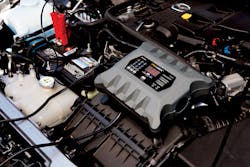Batteries are an integral part of a vehicle, and they’ve taken on much more responsibility since the days of just being used to start a vehicle until the alternator takes over.
Vehicle batteries today are required to handle more load and to cycle more deeply than before due to the amount of power needed for different systems in the vehicle.
Now, the load placed on batteries continues to increase as more systems and modules require power to operate. On top of that, a shift in the adoption of start-stop technology by vehicle manufacturers, to address meeting fuel efficiency standards, requires battery power to maintain these systems to conserve fuel.
Vehicle battery trends
In the mid- to late-2000s, some vehicle manufacturers began to replace the standard flooded lead-acid battery and enhanced flooded battery with an AGM battery, to help address this change.
Kimberly Cottle, president and CEO, Associated Equipment, explains that this trend has already seen heavy adoption in the market. Associated Equipment is a provider of quality battery chargers, testers, analyzers and other battery servicing equipment.
“There are more than 20 million vehicles in the U.S. alone utilizing AGM batteries that require specialized charging different from traditional flooded lead-acid batteries,” says Cottle. “Twenty-seven OEM vehicle manufacturers and over 900 (vehicle) models now come factory installed with AGM batteries.”
AGM, or absorbed glass mat, refers to the construction of the battery. Unlike flooded lead-acid batteries which have plates that are submerged in an electrolyte solution, each plate in an AGM battery is wrapped in a fiberglass mat. Without going into too much detail on the construction of the battery, this design allows for better battery cycling, allowing the battery to be discharged more deeply than a typical flooded battery.
Why is this important?
“If you look at starter draw, what does it take to start a vehicle today? Significantly less (power), because the vehicle is much more efficient. But, the battery is being asked to do much more. We’re running nav(igation), DVD players, all kinds of modules on the vehicle that are demanding power at the same time,” says Jim O’Hara, vice president, marketing, Clore Automotive. Clore Automotive designs, develops and manufactures automotive service equipment.
In addition to the shift to a different battery type for new vehicles on the road today, many vehicle manufacturers have adopted, or are in the process of implementing, start-stop technology into vehicles. This is mainly due to changes in CAFÉ standards to increase fuel efficiency in vehicle fleets. The location and type of battery for this technology is dependent on vehicle manufacturer, and is generally in addition to the standard vehicle battery found under the hood. While this technology can be found in some traditional hybrid vehicles, a hybrid electric powertrain is not required to have a start-stop system in a vehicle.
“Start-stop vehicles use internal combustion engines that automatically shut off when the car is idling, then restart when the driver’s foot leaves the brake pedal. When the engine is off, the vehicle’s electrical system uses energy from the battery, and the battery is used to restart the engine after each stopping event. When the driver disengages the clutch pedal ready to pull away, or releases the brake pedal in an automatic vehicle, the engine automatically restarts,” explains Cottle.
In general, AGM or enhanced flooded batteries are used in start-stop systems.
“Start-stop puts even greater demand on the vehicle. All of the original demands don’t change. They’re still there, but now (when) I come to a stop at a traffic light or a railroad crossing, the engine shuts down, and now everything is running off the battery,” says O’Hara.
There is also a different method for servicing a battery in a start-stop system.
“The technician cannot just replace the battery in the way that they have done with a traditional battery. Instead, as the battery is intricately linked to the vehicle’s on-board electronics via a battery management system (BMS) or intelligent battery sensor (IBS), it has to be integrated into the system and paired with the BMS/IBS, which requires special equipment. Without the equipment to assist the technician and introduce the battery into the system, the vehicle could illuminate error messages on the dash, fail to charge the battery or simply not start at all,” says Cottle.
“The reality of the situation is that start-stop systems, and therefore AGM batteries, already are – and are going to increasingly be – an issue for aftermarket shops to deal with,” adds O’Hara.
Breakdown of different battery service equipment types
Some battery service equipment products will be shop purchases, while others will be technician purchases.
Cottle explains that smart battery chargers are typically a shop purchase, depending on the number of bays in the shop, along with load testers and multi-unit, or wheeled, battery chargers. Technician purchases include memory savers, jump starters, bench top battery chargers, battery maintainers and battery testers.
For the product types listed below, product features can sometimes be combined into one unit. For example, you may have a battery charger and tester unit that completes some or all of the functions of both items described.
Jump starters
A recent trend in the last few years has been portable jump starters. These smaller devices – sometimes the size of a smartphone – assist with jump starting a battery. The units can also include additional features such as a light or USB port for charging small electronics. It is important to note that while a jump starter assists with starting a vehicle through the battery, the unit itself cannot recharge a vehicle’s battery.
“Since all jump starters depend on an internal battery as their power source, they must also be re-charged after each use, and periodically while not in use, to keep their battery charged,” Cottle says.
“The vehicle’s charging system (alternator) will take care of re-charging the vehicle’s battery, assuming it’s in proper working order, after being jump started,” she adds.
Battery chargers
While many shops have the traditional battery charger still in the shop, the need for smart chargers has continually increased. Smart chargers are micro-processor controlled and provide multi-stage charging to optimally charge a number of different battery types seen in repair shops today – including AGM, flooded lead-acid and enhanced flooded battery types. This also refers to start-stop system batteries. How fast a battery charger works is dependent on amperage output. The higher the amperage, the faster the charge.
“Traditional lead acid battery chargers are not compatible with AGM batteries and, if used, will damage and severely reduce the life of the battery. Always use an AGM-compatible charger when working with start-stop batteries,” Cottle says.
“Charging is becoming less of a reactive event and more of a proactive event,” explains O’Hara. “The charger’s role in the shop is changing. That’s accelerating the shift away from wheel chargers and toward portable chargers, because now it’s a charger in every bay – vehicle comes in, hood goes up, charger goes on the vehicle,” says O’Hara.
O’Hara adds that the reasons for this shift are as follows: the need for maintenance charging for each vehicle’s battery that comes into the shop, to ensure the battery is optimally mated to the vehicle system; to provide stable battery voltage for diagnosing electronic components; and for having a steady source of power on the battery for repairing electronic systems on a vehicle.
Smart battery chargers also control voltage through each charging phase.
“AGM batteries, spiral wound, gel cell, start-stop AGM batteries, are all very sensitive to voltage. At the end of the day, voltage equals pressure, and (these batteries) don’t want to be over-pressured. If they’re over-pressured, they can start to degrade internal structure of the battery,” says O’Hara.
Memory savers
Memory savers are used during battery replacement to avoid resetting vehicle modules. They are connected to the vehicle through the OBD II connector, or through the 12V power port, before the battery is removed.
“Memory savers are basically backup batteries that are lower amperage used during battery replacement to retain programmed vehicle memory modules,” explains Cottle.
Battery maintainer
Sometimes labeled as a “power supply” mode on a battery charger, the function of a battery maintainer is to keep a fully charged battery continually charged. This is sometimes referred to as float voltage, according to Cottle.
Float voltage is the voltage a battery is maintained at after being fully charge. The appropriate float voltage varies significantly based on chemistry and construction of the battery, and ambient temperature,” says Cottle.
While they may be similar to memory savers, battery maintainers are used when a battery is disconnected or removed from a vehicle completely. They are often used for batteries on vehicles or boats when those vehicles are in long-term storage, to prevent battery discharge.
O’Hara adds that during collision repair and welding applications techs will often remove the battery from the vehicle and hook it up to a battery maintainer away from the vehicle, for safety reasons.
Flashing power supply
Taking “power supply” a step further, there has been a continually increasing trend in vehicle reflashing and reprogramming, which requires a stable power supply to the vehicle, at a certain voltage, when this service is completed.
“For flashing, you need a very high (voltage) output,” explains O’Hara.
Not to be confused with a battery maintainer, many battery service equipment manufacturers today market and sell units specially designed for maintaining proper vehicle voltage during a programming event.
The voltage needed is based on OE specifications, and can range anywhere from 55 amps to 100 amps.
Battery testers
Generally used for more vehicle system diagnosis, O’Hara explains battery testers test the battery’s capacity, the starting system and the charging system (alternator).
“We test with loads on, and without loads on. And then we’re also assessing alternator ripple, meaning what’s the variation,” explains O’Hara. “And if there’s excessive ripple, it probably means there’s something inside that alternator that’s not functioning properly, like a diode.”
For more information about battery service equipment used for vehicle diagnosis, turn to page xx.
Overall, trends will continue to shift as the vehicle battery plays a larger role in providing creature comforts to drivers, as well as operating necessary systems for the vehicle. This also means that the tools and equipment required to service batteries will continue to change.



